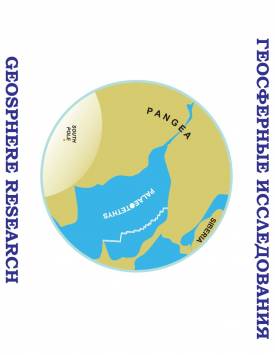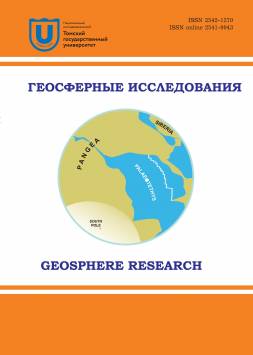Ultramafic and mafic rocks of the Northern Kraka massif (Southern Urals): petrography, mineralogy and geochemistry
The paper presents the results of studies of ultramafic and mafic rocks of the Northern Kraka massif (Southern Urals). Petrographic, mineralogical and geochemical features and conditions of rock formation are characterized. The massif has outcrops of peridotites with low degrees of secondary alteration, which makes its study important for understanding the processes of mineral formation. Petrographic studies were carried out by optical and scanning electron microscopy methods, chemical composition of minerals was determined using an energy-dispersive spectrometer. The bulk composition of rocks was determined by silicate analysis, the content of impurity elements, including rare-earth elements, was determined by ICP-MS (inductively coupled plasma mass spectrometry). Mineralogy and composition of rock-forming and accessory minerals of peridotites and mafic rocks, as well as their bulk macro- and trace-element compositions were described, and discriminative diagrams for mineral species were plotted. Olivine of ultramafic rocks is represented by highly magnesian variety, orthopyroxenes mainly by enstatite, clinopyroxenes of both ultramafic and mafic rocks - by diopside and augite, in the latter it is highly titanic. Feldspars in mafic rocks correspond to labradorite, bytownite, and potassium feldspar. Cr-spinels form a wide variation of Cr-Al compositions, increasing #Cr from lherzolite to chromitite. Mafic rocks from the serpentinite melange of the Northern Kraka periphery are composed of highly titaniferous augite, plagioclase and potassium feldspar, which distinguishes them from typical ophiolitic gabbros. REE contents in both mafic rocks and peridotites show subhorizontal distribution relative to the estimated pyrolite composition, with REE contents in mafic rocks 1-2 orders of magnitude higher than in peridotites. Significant gross contents of alkaline-earth metals in mafic rocks are consistent with a large proportion of leucocratic minerals. Peridotites of the massif are formed as restite from partial melting of the primitive mantle source, which reached values at most 25 %. The mafic rocks are differentiates of melts extracted from peridotite at much lower degrees of melting (about 15 %), which is also evidenced by the high content of sodium and potassium. In accordance with this infer is also the conclusion that the formation of parental melts for mafic rocks occurred at earlier stages of diapir development. This is evidenced by the greater depth of melt extraction, corresponding to the spinel facies, while the final position of peridotites corresponds to the transition from spinel to plagioclase facies. Contribution of the authors: the authors contributed equally to this article. The authors declare no conflicts of interests.
Keywords
ultramafic rocks,
mafic rocks,
peridotites,
ophiolites,
Northern KrakaAuthors
| Gataullin Ruslan A. | Institute of Geology – Subdivision of the Ufa Federal Research Centre, RAS | rusgatln97@gmail.com |
| Saveliev Dmitrii E. | Institute of Geology – Subdivision of the Ufa Federal Research Centre, RAS | savl71@mail.ru |
| Kiseleva Darya V. | Zavaritsky Institute of Geology and Geochemistry, UB RAS | kiseleva@igg.uran.ru |
Всего: 3
References
Брянчанинова Н.И. Породообразующие силикаты ультрабазитов как индикаторы условий образования и рудоносности. Сыктывкар : Коми науч. центр УрО АН СССР, 1990, 22 с. (Сер. препринтов «Научные доклады»; Вып. 226).
Дмитриев Л.В., Уханов А.В., Шараськин Л.Я. К вопросу о составе вещества верхней мантии // Геохимия. 1972. № 10. C. 1155-1167.
Москалева С.В. Гипербазиты и их хромитоносность. Л. : Недра, 1974. 279 с.
Петрографический кодекс России: Магматические, метаморфические, метасоматические, импактные образования / под ред. О.А. Богатикова, О.В. Петрова, А.Ф. Морозова ; отв. ред. Л.В. Шарпенок. 3-е изд., испр. и доп. СПб. : ВСЕГЕИ, 2009. 200 с.
Савельев Д.Е., Гатауллин Р.А. Акцессорная платиноидная минерализация в лерцолитах массива Северный Крака (Южный Урал) // Георесурсы. 2023. № 25 (3). С. 208-215. doi: 10.18599/grs.2023.3.24.
Савельев Д.Е., Гатауллин Р.А. Лерцолиты Азнагуловской площади (Южный Урал): состав и P-T-/O2 условия образования // Вестник Академии Наук РБ. 2021. T. 40, № 3 (103). С. 15-25.
Савельев Д.Е., Масагутов Р.Х., Сирота С.Н. Минералогические особенности и субсолидусные структуры израндитов Александровского комплекса // Геологический вестник. 2022. № 2. С. 30-47. doi: 10.31084/2619-0087/2022-2-3.
Савельев Д.Е., Пучков В.Н., Сергеев С.Н., Мусабиров И.И. О деформационно-индуцированном распаде энстатита в мантийных перидотитах и его значении для процессов частичного плавления и хромитообразования // Доклады Академии наук. 2017. Т. 476, № 2. С. 200-204.
Савельев Д.Е., Сначёв В.И., Савельева Е.Н., Бажин Е.А. Геология, петрогеохимия и хромитоносность габбро-гипербазитовых массивов Южного Урала. Уфа : ДизайнПолиграфСервис, 2008. 320 с.
Савельев Д.Е., Нугуманова Я.Н., Гатауллин Р.А., Сергеев С.Н., Мусабиров И.И., Блинов И.А. О новых проявлениях платинометальной минерализации в офиолитовых ультрамафитах Южного Урала // Петрология магматических и метаморфических комплексов : материалы X Всерос. петрографической конф. с междунар. участием. 2018. Вып. 10. C. 321-325.
Савельева Г.Н. Габбро-ультрабазитовые комплексы офиолитов Урала и их аналоги в современной океанической коре. М. : Наука, 1987. 230 с.
Скляров Е.В., Гладкочуб Д.П., Донская Т.В., Иванов А.В., Летников Е.Ф., Миронов А.Г., Бараш И.Г., Буланов В.А., Сизых А.И. Интерпретация геохимических данных : учеб. пособие. М. : Интернет Инжиниринг, 2001. 288 с.
Сначёв В.И., Савельев Д.Е., Рыкус М.В. Петрогеохимические особенности пород и руд габбро-гипербазитовых массивов Крака. Уфа, 2001. 212 с.
Соболев Н.Д. Ультрабазиты Большого Кавказа. М. : Госгеолиздат, 1952. 240 с.
Чернышов А.И. Ультрамафиты (пластическое течение, структурная и петроструктурная неоднородность). Томск, 2001. 215 с.
Чернышов А.И., Юричев А.Н. Структурная эволюция дунитов и хромитов Харчерузьского массива (Полярный Урал) // Геотектоника. 2016. № 2. С. 62-77. doi: 10.7868/S0016853X1602003X.
Щербаков С.А. Пластические деформации ультрабазитов офиолитовой ассоциации Урала. М. : Наука, 1990. 120 с.
Albarede F. Residence time analysis of geochemical fluctuationsin volcanic series // Geochimica et Cosmochimica Acta. 1995. No. 57. P. 615-621.
Arai S. Characterization of spinel peridotites by olivine-spinel compositional relationships: Review and interpretation // Chemical Geology. 1994. No. 113. P. 191-204.
Ballhaus C., Berry R., Green D. High pressure experimental calibration of the olivine orthopyroxene-spinel oxygen geobarometer: Implication for the oxydation state of the upper mantle // Contribution to Mineralogy and Petrology. 1991. V. 107. P. 27-40.
Barry T.L., Saunders A.D., Kempton P.D., Windley B.F., Pringle M.S., Dorjnamjaa D., Saandar S. Petrogenesis of Cenozoic Basalts from Mongolia: Evidence for the Role of Asthenospheric versus Metasomatized Lithospheric Mantle Sources // Journal Of Petrology. 2003. V. 44, No. 1. P. 55-91.
Brey G.P., Kohler T. Geothermobarometry in 4-phase lherzolites: 2. New thermobarometers, and practical assessment of existing thermobarometers // Journal of Petrology. 1990. V. 31. P. 1353-1378.
Chauvel B.-T. A hafnium isotope and trace element perspective on melting of the depleted mantle // Earth and Planetary Science Letters. 2001. No. 190. P. 137-151.
Fabries J. Spinel-olivine geothermometry in peridotites from ultramafic complexes // Contribution to Mineralogy and Petrology. 1979. V. 6. P. 329-336.
Hellebrand E., Snow J.E., Dick H.J.B., Hofmann A. Coupled major and trace elements as indicators of the extent of melting in mid-ocean-ridge peridotites // Nature. 2001. P. 677-681.
Hou T., Zhang Zh., Encarnacion J., Santosh M. Petrogenesis and metallogenesis of the Taihe gabbroic intrusion associated with Fe-Ti-oxide ores in the Panxi district, Emeishan Large Igneous Province, southwest China // Ore Geology Reviews. 2012. V. 49. P. 109-127.
Leake B.E., Woolley A.R., Arps C.E.S., Birch W.D., Gilbert M.C., Grice J.D. et al. Nomenclature of amphiboles; report of the subcommittee on amphiboles of the International Mineralogical Association commission on new minerals and mineral names // Canadian Mineralogist. 1997. V. 35. P. 219-246.
McDonough W.F., Sun S.-S. The composition of the Earth // Chemical Geology. 1995. V. 120, Is. 3-4. P. 223-253.
Morimoto N. Nomenclature of pyroxenes // Canadian mineralogist. 1989. V. 27. P. 143-156.
Putirka K.D. Thermometers and barometers for volcanic systems // Reviews in Mineralogy and Geochemistry. 2008. V. 69. P. 61-120.
Roeder R.L., Campbell E.H., Jamieson H.E. A reevaluation of the olivine-spinel geothermometer // Contribution to Mineralogy and Petrology. 1979. V. 68. P. 325-334.
Sun S., McDonough W.F. Chemical and isotope systematics of oceanic basalts: implications for mantle composition and processes. In: Saunders A.D. & Norry M.J. (eds) Magmatism in the Ocean Basins // Geological Society, London, Special Publications. 1989. No. 42. P. 313-345.
Weiblen P.W., Morey G.B. A summary of stratigraphy, petrology and structure of the Duluth complex // American Journal of Science. 1980. V. 280 A. P. 88-133.
Wells P.R.A. Pyroxene thermometry in simple and complex systems // Contribution to Mineralogy and Petrology. 1977. V. 62. P. 129-139.

